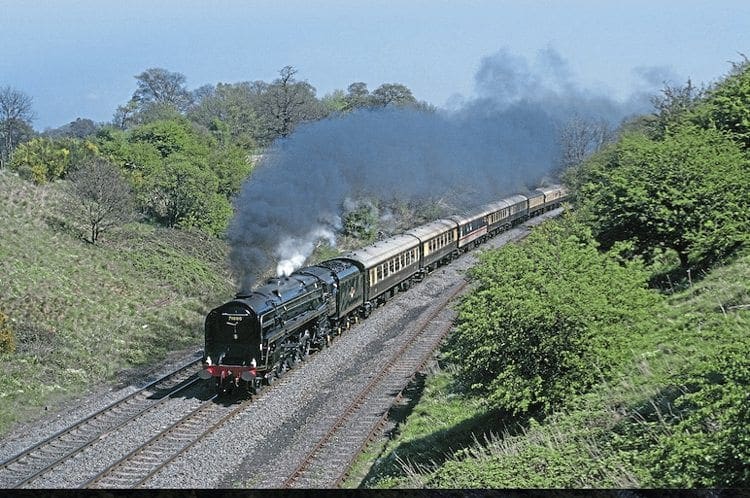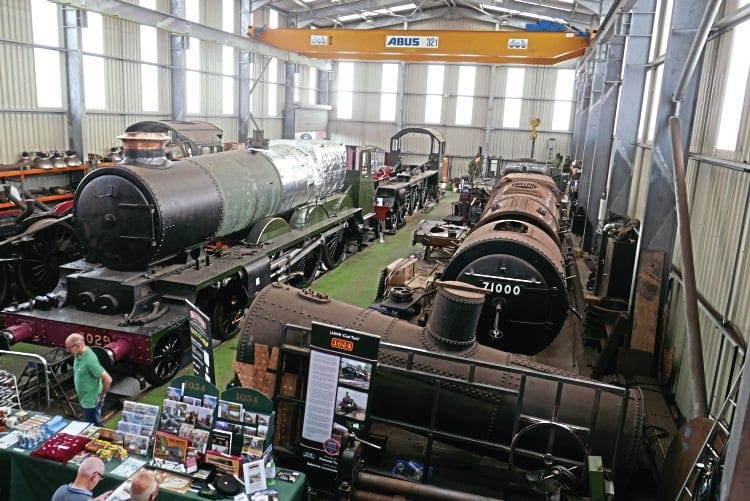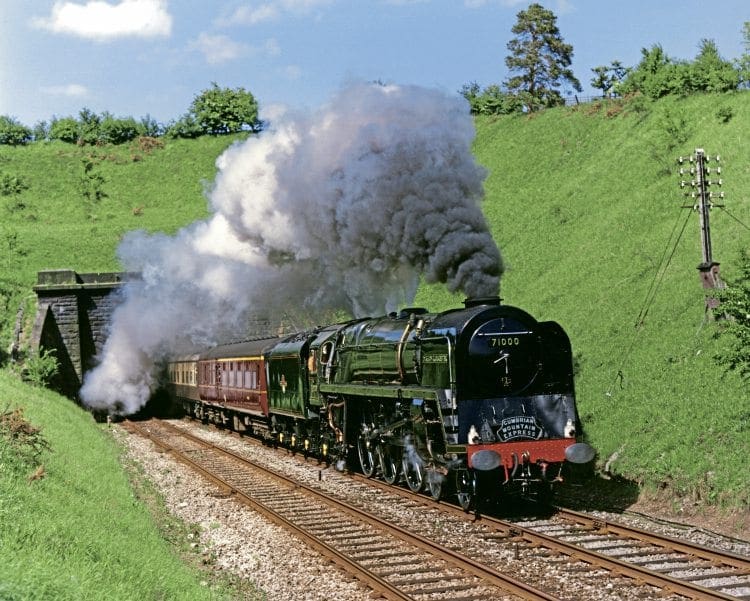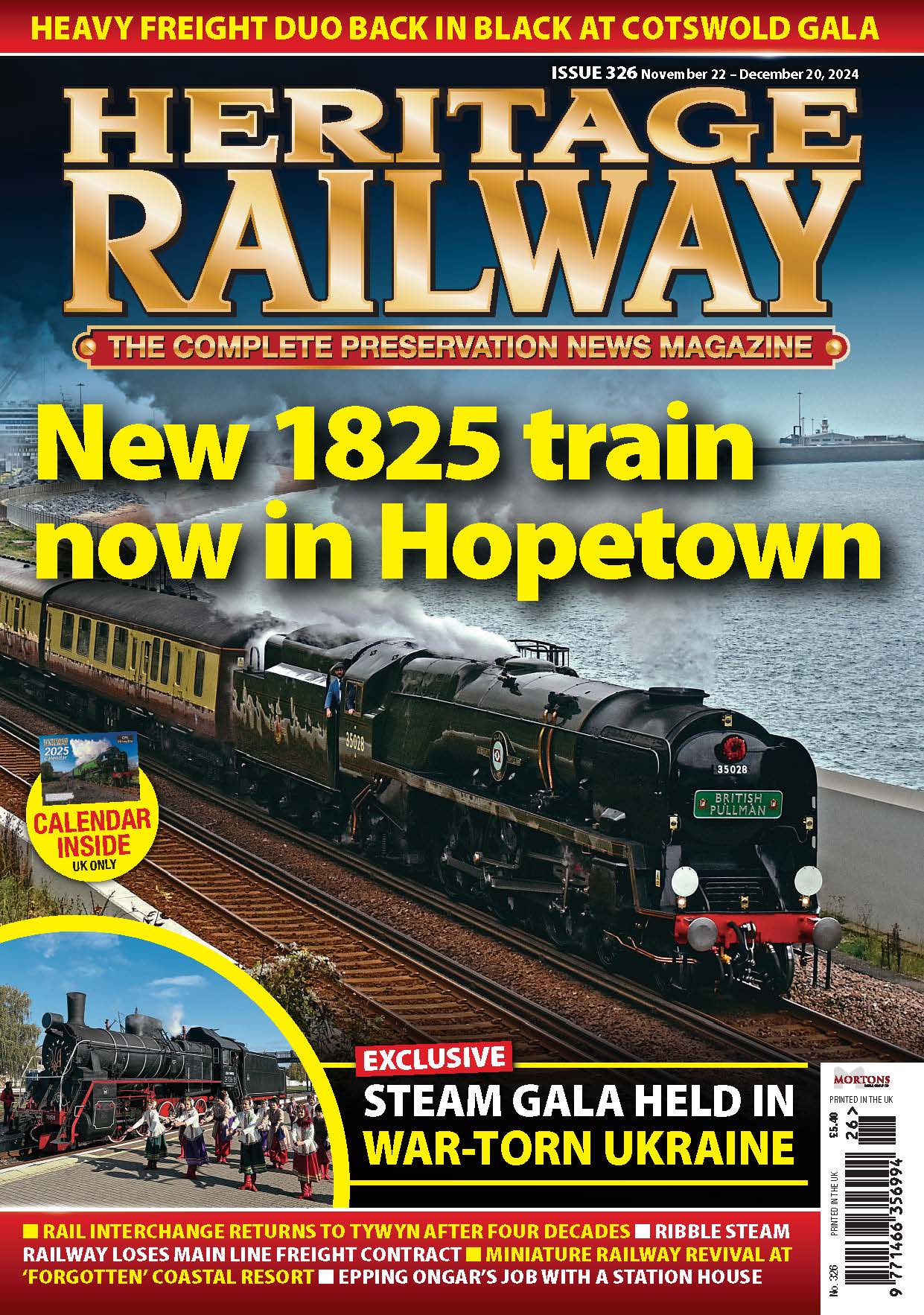In the final part of our series marking 30 years since unique BR 8P Pacific No. 71000 Duke of Gloucester returned to steam, Ian Murray looks at the record-breaking performances of the locomotive beyond which it could have achieved under BR.
The year 1986 was to prove pivotal in many ways for the No. 71000 Duke of Gloucester restoration team.
Twelve long years since the butchered remains of the Class 8 prototype Pacific had arrived on the then nascent Great Central Railway, the finishing line was in sight.
The Duke was complete, fully painted and lined… but had two rather important components missing – the rear sections of the coupling rods which had still to be delivered from Brush. Undeterred the team elected to run a members’ special on October 3, 1986 along what had become, by then, a GCR of respectable length, the locomotive running as a 4-4-2-2! This event ranks as one of the more bizarre episodes in the life of this unique locomotive, although the team had, by that time, run several trips up and down the line with the locomotive hauling just two coaches.
Enjoy more Heritage Railway reading in the four-weekly magazine.
Click here to subscribe & save.
The feelings of elation and excitement of members finally being hauled by the machine they toiled on for so long is hard to imagine.
November 11, 1986 (Armistice Day) was the day chosen for the official re-naming and re-dedication of the by-now-completed No. 71000 and this took place amid suitable pomp and splendour at Rothley. HRH The Duke of Gloucester (the human counterpart!) himself drew back the curtain to reveal the new nameplate, proceeding then to the footplate where, after donning a pair of overalls, he tried his hand at the regulator as No. 71000 took the train to Loughborough and back.
After that the loco settled in for a period of public running on the GCR as a ‘thank you’ for its help and support over the years.
In June 1987 the Duke left the line to take part in a major exhibition at Crewe, alongside other notable products of Crewe including LMS 4-6-2 No. 6201 Princess Elizabeth.

Also, the Wheelset Manufacturing Company of Manchester had offered to make new tyres for the locomotive and tender free of charge, so the opportunity was taken to lift the locomotive at Crewe works. While this work was going on, thoughts naturally turned to the future and whether the team should now be looking at returning the Duke to the main line.
Limited though the opportunity was to open up the Duke on the GCR, nonetheless the locomotive had shown much promise. In addition, everyone involved now wanted to know whether the fitting of the Kylchap exhaust plus other changes had eliminated the problems which had bedevilled the locomotive in BR service.
However, such ambition was not to be easily achieved. Once the Duke was sitting on its newly retyred wheels it became apparent that a BR inspector’s report on the internal examination of the boiler was missing. Furthermore, advice and guidance given to the restoration team over the years now proved to be at variance with regulations introduced that January.
In order to gain access to the main line the boiler now needed to be stripped of all superheater elements and tubes plus all smoke tubes. In addition some mechanical strip down was required, including poppet valves and gear.
It is hard to imagine a more demoralising choice which then confronted the team. They could elect to have the Duke trundle up and down various preserved lines for the next 10 years, then seek main line certification as part of the next overhaul, or they could bite the bullet and get on with the work. To their eternal credit this team girded their loins for this last, major, challenge.
The sheer frustration of having to gut the boiler is hard to imagine (plus the financial costs) and the fact that the BR boiler inspector declared the empty shell ‘immaculate’ on February 28, 1989 was probably little compensation. The boiler had then to be retubed, new superheater elements sourced and British Timken undertook some work to the roller bearings.
It was not until February 8, 1990 – almost three years since the Duke returned to Crewe – that 71000 passed the BR examination in steam and the scene was set for the Duke’s long-anticipated return to the main line.
Moment of truth
It was 10.25am on Wednesday, March 14, 1990, five minutes after scheduled departure time of the BR test train, when a lengthy blast from the Duke’s chime whistle indicated that, finally, the moment of truth had arrived.
Would the locomotive, with all its improvements, finally demonstrate the potential which Riddles and his team had built in from the beginning? Clouds of black smoke rolled across Derby station as, after
a brief wheel slip, the Duke ‘picked up’ its 14 coach (507 tons) train and began to accelerate.
Those on the footplate were old hands at putting steam locomotives through their paces. However, even they were surprised to find that No. 71000 was capable of whisking this huge train around the Derby-Sheffield-Derby circuit at a speed almost on a par with the then timetabled Inter City 125 trains (280 tons and two diesel power units).
No. 71000 had achieved a steaming rate of only 34,000lb per hour on the Swindon test plant way back in 1955, but now it was producing 45,000lb ‘on the road’ with much more in reserve. This was most evidently not the Duke of old, but a very different machine and one which would seem capable of even greater performances.
That historic day was the beginning of a brand new era.
Early tours threw up a few teething problems with the return cranks and rocking grate but these were gradually addressed and on an early tour from Marylebone the locomotive tackled Hatton bank with such ease that a seasoned enthusiast was moved to remark: ‘Hatton bank – what bank?’
Most of the early runs were focused on the Didcot area given that the Great Western Society at Didcot had made its facilities available to the team for the boiler and other work necessary to work on the main line. However, in June 1990, No. 71000 was at the head of a train which took the iconic locomotive back to its spiritual home – Crewe. In a wonderful gesture the then area manager, Jan Glasscock, was on the platform to greet the Duke complete with bowler hat.
This now would be the true test as, at that time, there were still BR employees who had experience of the Duke in service and they would take some convincing that the performance of this ‘near miss’ had been transformed. One ex-Crewe North driver apparently said: “There is no getting away from the fact that (the Duke) was considered by the drivers and firemen … as the greatest disaster ever to have come off the drawing boards.”

This is perhaps a little harsh, but the point is well made. That summer the Duke, berthed on Crewe Heritage Centre and immaculately turned out by its gang of dedicated cleaners, gave several immaculate performances on the ‘North Wales Coast Express’ to Holyhead.
This route is fast and hardly taxing, except for the nasty gradient which begins at the platform end at Holyhead. The Duke showed complete mastery of this climb, with all loads, and later in the summer on the ‘Ynys Mon Express’ trains repeated the performance.
By this time the drivers were running with the short cut-offs which the Caprotti valve gear allows, with their firemen able to keep three quarters of a glass of water and pressure just below blowing off – a state of affairs unheard of in times past.
Thus were ingrained prejudices slowly overturned and the Crewe men delighted in the fact that their ‘black sheep’ was clearly transformed but, and it was a big but, was it now the equal of their beloved Duchesses? Time would tell and the Northern Fells were not going anywhere.
In September 1990, the Duke departed Crewe for Carnforth to do battle with the Settle-Carlisle line, a route over which it had never previously worked.
By this period the 15 mile 1-in-100 gradient, forming the southbound climb to Ais Gill summit from Carlisle, was regarded as the definitive test for both engines and crews. The importance of this test was not lost on the Duke’s team as all recognised the fact that Princess coronation 4-6-2 No. 46229 Duchess of Hamilton was the current holder of the fastest ascent of this gradient and, moreover, that record had stood for almost seven years.
On its second southbound run on Sept 30, the Duke, on wet rails and hauling a 14-coach train (512 tons as against 485 tons hauled by the Duchess), came within 27 seconds of beating the Duchess’s time. Although there was disappointment the enginemen made it clear that No. 71000 had ‘more in it yet’.
It was not until July 20, 1991 that the Duke had an opportunity for a tilt at the Duchess’s crown. It was to be the last run of the summer (which had been marked by either excessive rain or tinder dry conditions with its associated fire risk) and on the footplate was the experienced crew of driver Willie Alexander and fireman Paul Kane. These were the pair who had set the record with the Duchess, so expectations were high.
The Blue Riband
Departure from Appleby was dramatic with startling acceleration. The ‘Long Drag’ was taken at an average speed of 53.8mph and the summit topped in 17 minutes – almost a minute faster than the Duchess. The Duke had taken the Blue Riband and, in Paul Kane’s words, “No problem at all”. Steaming throughout the climb had been consistent, the injectors had kept up and water had been maintained at three quarters of a glass.
This was vindication of all the thought and hard effort which had been put into the Duke rebuild. Or was it? This was, after all, the hated Midland route. To the Crewe purists there was only one true test, Shap.
What visions of effort are thrown up by that word? That whole panoply of LNWR locomotives, followed by all Stanier’s designs, doing battle with the incline, often after some 250 miles of hard running from Euston. The five-mile climb of Shap itself is preceded by the 13 mile climb to Grayrigg (interspersed with a more or less level five-mile stretch along the Lune valley) and it is the surmounting of the two climbs that is the real test.
It was the Shap Trials in October 1995 which gave the Duke its first opportunity in rebuilt form to show its mettle on home turf. To add to the excitement it was pitted not simply against its one time fellow Crewe North shed resident Duchess of Hamilton, but also against its LNER rival A4 Sir Nigel Gresley. In the event it was a triumph for the Duke which, on a wet rail and in the teeth of rain and high wind, topped the summit at over 50mph, both safety valves lifting as the regulator was eased.
Over the next few years the Duke ranged far and wide across the UK setting new standards and indeed new records on the likes of the South Devon banks etc. Consistently turned out to a very high standard the Duke became a firm favourite with many, its staccato exhaust, melodious chime whistle and mysteriously revolving Caprotti drive shafts combining to give it an extra ‘something’.
My first trip behind the Duke was in East Anglia in, from memory, 1993 and it was the sound of that exhaust combined with the electrifying acceleration which caught my attention.
It was after its first overhaul on the expiry of its boiler ‘ticket’ that things began to go awry for the Duke. The locomotive is owned by a private limited liability company (formed in the early years of the rebuild) which had leased the locomotive to a charitable trust. This trust had the responsibility to run, maintain and generally look after the company’s asset. Regrettably there was a deterioration in the relationship between the owning company and the trust which resulted in the trust severing contact with the company. This left the company with no say in how their asset was managed.
There then followed a steady deterioration of relationships within the trust itself which, almost inevitably, led to a fall-off in the reliability of the locomotive itself. Slowly but surely a question mark was placed against the Duke in terms of reliability and, after a number of incidents, the Duke was failed with issues in one of its camboxes. This led to the locomotive being withdrawn from traffic with its reputation plus the reputation of the trust at a very low ebb.
The Duke then sat on Crewe Heritage Centre while ways forward were sought.

Eventually the managing trust recognised that the breakdown in internal relationships was final and, with little cash behind them, took the decision to hand the locomotive back to the owning company and put themselves into voluntary liquidation. The owning company, having accepted custody of their asset, immediately began the process of setting up a new charitable trust to manage the Duke on their behalf. This time steps were taken to ensure that the interests of both the company and the trust were better aligned in order not to repeat the previous mistakes.
Hard and fast
Thus came into being the BR Class 8 Steam Locomotive Trust which quickly put in place a management committee (now comprising trustees and shareholders) which has moved hard and fast to map out a future for the Duke.
The view has been taken that, on our current contractually interdependent railway, there is a great need to be as professional as possible. There is still a place for the individual who wants to get hands on with ‘their’ engine but the trust has partnered with Tyseley Locomotive Works to undertake the bulk of the current ‘heavy general’ overhaul. It is the intention that Tyseley also provide the ongoing rolling maintenance.
Working in tandem with Tyseley are the trust’s fortnightly working parties, where the growing band of support crew are tacking the many and varied jobs which are interesting and rewarding from the individual trust member’s perspective. No engineering experience is necessary. Our steadily growing membership is providing the monthly income to enable us to fund the work as this is progressing and we have deliberately not been making public appeals for people’s cash.
That said we will happily welcome anyone who wishes to join our merry band.
The Duke is a unique piece of our nation’s engineering heritage in so many ways. It was a prototype, therefore, as no others were built, it is unique. It is not the next one of a long defunct class, it is a complete one-off. It is the sole representative of the direction in which British steam locomotion would have gone had BR not embarked upon their ‘dash for diesel’.
To that extent it is a glimpse of an alternative future. The tale which I have related in this series of articles in terms of the rescue from Barry again makes this locomotive unique, acting as it has as a pathfinder for the various groups which have set out on their own journeys since. Truly our broad movement today owes much to the vision, hard work and sheer grit of the team that took on the Duke from Barry. “Never, in the field of UK steam restoration, has so much been owed by so many to so few”, to paraphrase Churchill.
In January 1987 at the annual meeting of the Association of Railway Preservation Societies, the Duke’s team received the Association’s Premier Award for the most outstanding achievement of 1986.
John Bellwood OBE, the then CME of the National Railway Museum, in presenting the award commented that the Duke team had “now rewritten preservation history and no project could be written off as impossible”. It is my personal view that we, today, owe a huge debt of gratitude to these plucky pioneers and that we have a duty to them to return the Duke to the main line as quickly as possible.
The world is a quieter and more boring place without that staccato Caprotti roar.
Read more News and Features in Issue 232 of HR – on sale now!
Archive enquiries to: Jane Skayman on 01507 529423 – [email protected]
Advert
 Enjoy more Heritage Railway reading in the four-weekly magazine. Click here to subscribe.
Enjoy more Heritage Railway reading in the four-weekly magazine. Click here to subscribe.




